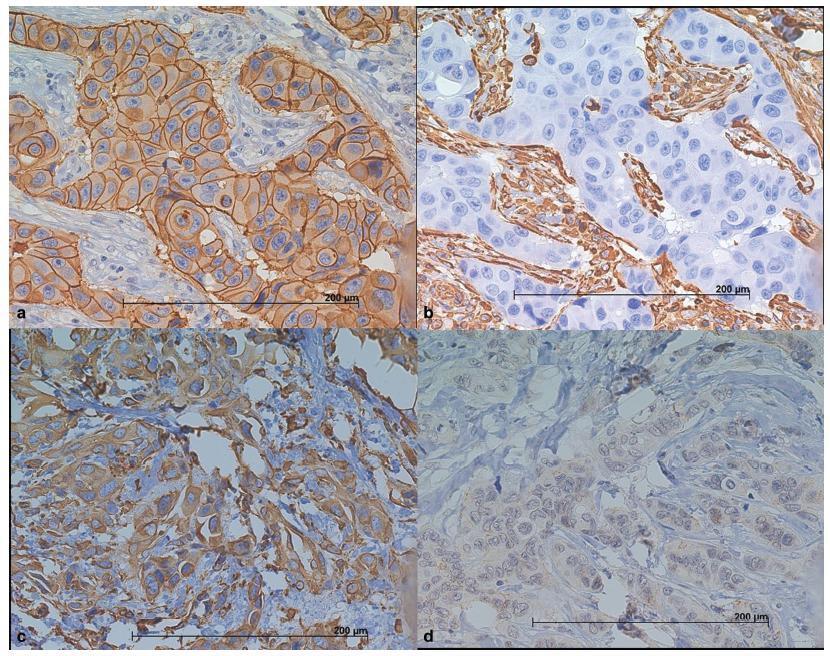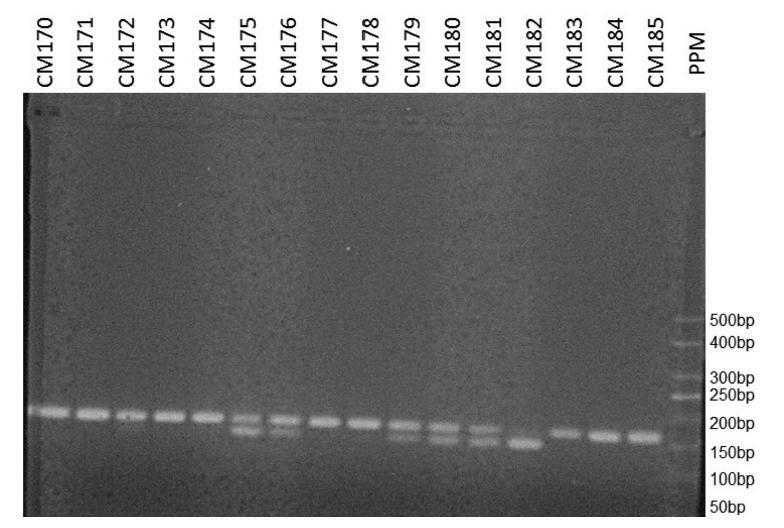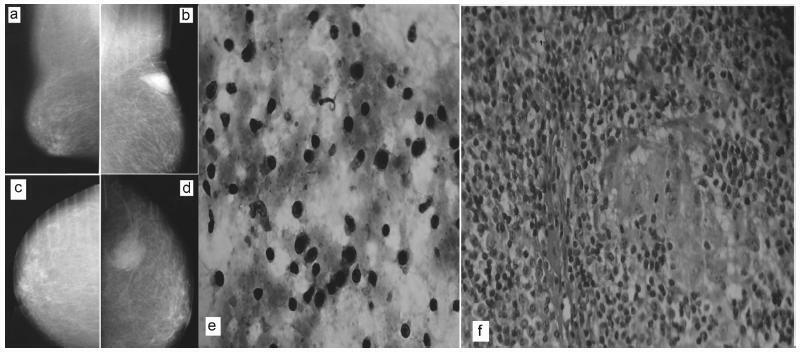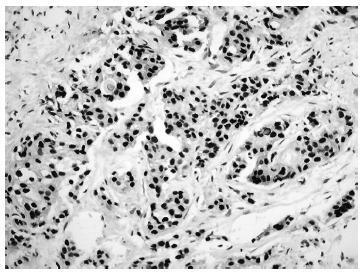-
Original Article01-19-2021
Switching of Hormone Therapies in Breast Cancer Women
Revista Brasileira de Ginecologia e Obstetrícia. 2021;43(3):185-189
Abstract
Original ArticleSwitching of Hormone Therapies in Breast Cancer Women
Revista Brasileira de Ginecologia e Obstetrícia. 2021;43(3):185-189
Views125See moreAbstract
Objective
The objective of the present study was to analyze the reasons that led to hormone therapies (HTs) regimen changes in women with breast cancer.
Methods
This was a retrospective cross-sectional study from a single-institution Brazilian cancer center with patient records diagnosed with breast cancer between January 2012 and January 2017.
Results
From 1,555 women who were in treatment with HT, 213 (13.7%) women had HT switched, either tamoxifen to anastrozole or vice-versa. Most women included in the present study who switched HT were > 50 years old, postmenopausal, Caucasian, and had at least one comorbidity. From the group with therapy change, ‘disease progression’ was reason of change in 124 (58.2%) cases, and in 65 (30.5%) patients, ‘presence of side effects’ was the reason. From those women who suffered with side effects, 24 (36.9%) had comorbidities.
Conclusion
The present study demonstrated a low rate of HT switch of tamoxifen to anastrozole. Among the reasons for changing therapy, the most common was disease progression, which includes cancer recurrence, metastasis or increased tumor. Side effects were second; furthermore, age and comorbidities are risk factors for side effects.
-
Case Report04-17-2020
Metachronic Breast and Cerebellar Neoplasm in a Young Patient
Revista Brasileira de Ginecologia e Obstetrícia. 2020;42(2):114-119
Abstract
Case ReportMetachronic Breast and Cerebellar Neoplasm in a Young Patient
Revista Brasileira de Ginecologia e Obstetrícia. 2020;42(2):114-119
Views219See moreAbstract
Several factors trigger the development of genetic mutations that are responsible for causing a neoplasm. Medulloblastoma is a malignant and invasive cerebellar neoplasm, that affects children and young adults. Mucinous carcinoma is a special type of breast cancer. Being a special atypical subtype of invasive carcinoma, it most frequently affects women of advanced age and represents 1 to 7% of all breast cancers. The reported case aims to show the rarity of the occurrence of desmoplastic medulloblastoma and mammary mucinous carcinoma in a young patient in a short period of time, in different sites, without direct anatomical attachment and without occurrence of metastasis. Initially, this patient had a desmoplastic medulloblastoma and was treated with lumpectomy and radiotherapy. After 13 months, the patient was diagnosed with a mucinous breast carcinoma, underwent mastectomy, adjuvant chemotherapy and is currently undergoing endocrinotherapy. We conclude, based on the metachronous characteristic of the neoplasia and clinical characteristics, that the patient is likely to have Li-Fraumeni syndrome, an autosomal dominant disease with mutation of the TP53 gene, which is the the main involved. Because the patient does not present all the characteristics of the phenotype of the syndrome, she can thus be classified as having Li-Fraumeni variant or Li-Fraumeni-like syndrome.
-
Original Article12-01-2018
Identification of a Subtype of Poorly Differentiated Invasive Ductal Carcinoma of the Breast Based on Vimentin and E-cadherin Expression
Revista Brasileira de Ginecologia e Obstetrícia. 2018;40(12):779-786
Abstract
Original ArticleIdentification of a Subtype of Poorly Differentiated Invasive Ductal Carcinoma of the Breast Based on Vimentin and E-cadherin Expression
Revista Brasileira de Ginecologia e Obstetrícia. 2018;40(12):779-786
Views197See moreAbstract
Objective
The use of molecular markers can identify a subgroup of tumors with distinct recurrence patterns. The present study aimed to characterize the immunohistochemical expression of vimentin (VIM), of E-cadherin (CDH1), and of cytokeratin 5 (CK5) in patients with invasive ductal carcinomas (IDCs).
Methods
We have constructed a tissuemicroarray (TMA) from87 patients with IDC of the breast. Immunohistochemistry (IHC) was performed to study the expression of estrogen and progesterone receptors (ER and PgR), human epidermal growth factor receptor 2 (HER2), VIM, CDH1, CK5, and Ki67. The tumors were classified as luminal A and B (n = 39), HER2 enriched (n = 25), and triple-negative (TNBC) (n = 23), based on the IHC expression.
Results
We have observed that luminal A and B tumors lack the VIM+/CDH1-/low phenotype. This phenotype was observed in 16.5% of the HER2+ tumors and in 60% of the TNBC tumors (p = 0.0001). Out of a total of 20 TNBC tumors, the CK5 (basal-like marker) was positive in 11 of them. The VIM+/CDH1-/low phenotype was observed in 5 CK5+ TNBC tumors (45%) and in 7 out of 9 CK5- TNBC tumors (78%) (p = 0.02). The median Ki67 index in the VIM+/CDH1-/low tumors was 13.6 (range: 17.8-45.4) compared with 9.8 (range: 4.1-38.1) in other tumors (p = 0.0007). The presence of lymph nodemetastasis was less frequent in patients with VIM+/CDH1-/low tumors (23% versus 61%; X2 test; p = 0.01).
Conclusion
Our findings suggest that the expression of VIM and CDH1 can identify a subset of IDCs of the breast with a mesenchymal phenotype associated with poor prognosis, high-grade lesion, and high mitotic index.

-
Original Article11-01-2018
The Influence of CYP3A4 Polymorphism in Sex Steroids as a Risk Factor for Breast Cancer
Revista Brasileira de Ginecologia e Obstetrícia. 2018;40(11):699-704
Abstract
Original ArticleThe Influence of CYP3A4 Polymorphism in Sex Steroids as a Risk Factor for Breast Cancer
Revista Brasileira de Ginecologia e Obstetrícia. 2018;40(11):699-704
Views266See moreAbstract
Objective
Epidemiological studies have shown evidence of the effect of sex hormones in the pathogenesis of breast cancer, and have suggested a relationship of the disease with variations in genes involved in estrogen synthesis and/or metabolism. The aim of the present study was to evaluate the association between the CYP3A4*1B gene polymorphism (rs2740574) and the risk of developing breast cancer.
Methods
In the present case-control study, the frequency of the CYP3A4*1B gene polymorphism was determined in 148 women with breast cancer and in 245 women without the disease. The DNA of the participants was extracted from plasma samples, and the gene was amplified by polymerase chain reaction. The presence of the polymorphism was determined using restriction enzymes.
Results
After adjusting for confounding variables, we have found that the polymorphism was not associated with the occurrence of breast cancer (odds ratio = 1.151; 95% confidence interval: 0.714–1.856; p= 0.564). We have also found no association with the presence of hormone receptors, with human epidermal growth factor receptor 2 (HER2) overexpression, or with the rate of tumor cell proliferation.
Conclusion
We have not observed a relationship between the CYP3A4*1B gene polymorphism and the occurrence of breast cancer.

-
Case Report08-01-2018
Fine-needle Aspiration Cytology to Identify a Rare Mimicker of Breast Cancer: Plasma Cell Mastitis
Revista Brasileira de Ginecologia e Obstetrícia. 2018;40(8):491-493
Abstract
Case ReportFine-needle Aspiration Cytology to Identify a Rare Mimicker of Breast Cancer: Plasma Cell Mastitis
Revista Brasileira de Ginecologia e Obstetrícia. 2018;40(8):491-493
Views191See moreAbstract
There are rare benign diseases that can mimic malignant breast neoplasms in the clinical exam and in mammography. We evaluated the contribution of an accessible procedure to most clinicians, the fine-needle aspiration cytology, to identify a rare mimicker of malignant breast neoplasms. A type 2 diabetic 85-year-old female presented with a 6-month history of a left breast lump. The physical exam and mammography were compatible with breast cancer. Nevertheless, after fine-needle aspiration cytology, the diagnosis was plasma cellmastitis. Once this rare diagnosis was established, the tumor was extirpated, and the final histologic diagnosis corroborated chronic plasma cellmastitis. The patient’s postoperative evolution was uneventful, and no other treatment was needed. Fine-needle aspiration cytology could be a valuable tool to identify rare mimickers of malignant breast neoplasms.

-
Original Article04-01-2017
Influence of Body Image in Women Undergoing Treatment for Breast Cancer
Revista Brasileira de Ginecologia e Obstetrícia. 2017;39(4):175-183
Abstract
Original ArticleInfluence of Body Image in Women Undergoing Treatment for Breast Cancer
Revista Brasileira de Ginecologia e Obstetrícia. 2017;39(4):175-183
Views305See moreAbstract
Objective
The objective of this study was to investigate the self-esteem of women with and without breast cancer regarding their body image.
Methods
A quantitative, case-control study in which 90 women with breast cancer were evaluated in the case group, and 77 women without breast cancer in the control group. For data collection, the body satisfaction scale (BSS), a scale adapted and validated in Brazil, and the Rosenberg self-esteem questionnaire were used. For the statistical analysis of the data, the Statistical Package for the Social Sciences software (IBM-SPSS, Chicago, Il, US), version 16.0 was used.
Results
Compared with the women without breast cancer, those with breast cancer were more dissatisfied with body image related to appearance. Women undergoing neoadjuvant chemotherapy were more dissatisfied with their appearance compared with those with cancer who were not undergoing this treatment. Mastectomy also accounted for more dissatisfaction concerning appearance among women who underwent the procedure compared with the women who were submitted to breast-conserving therapy.
Conclusion
Women with breast cancer were more dissatisfied with their body image compared with those without breast cancer, particularly following mastectomy or during chemotherapy. The self-esteem was found to be negatively affected in patients who were dissatisfied with their body image.
-
Original Article10-01-2016
The Apocrine Profile of Triple-negative Breast Carcinomas in Patients Aged 45 Years or Younger: favorable but rare features
Revista Brasileira de Ginecologia e Obstetrícia. 2016;38(10):512-517
Abstract
Original ArticleThe Apocrine Profile of Triple-negative Breast Carcinomas in Patients Aged 45 Years or Younger: favorable but rare features
Revista Brasileira de Ginecologia e Obstetrícia. 2016;38(10):512-517
Views200Abstract
Objective
Triple-negative breast carcinomas (TNBCs) represent a heterogeneous group of neoplasias, even though they generally exhibit a clinically more aggressive phenotype, and are more prevalent in young women. To date, targeted therapies for this group of tumors have not been defined. The aim of this study was to evaluate the frequency of the apocrine subtype in TBNCs from premenopausal patients as defined by the immunohistochemical expression of the androgen receptor (AR) and its association with: histological type; tumor grade; proliferative activity; epidermal growth factor receptor (EGFR) expression; and a basal-like phenotype.
Methods
A total of 118 tumor samples from patients aged 45 years or younger were selected and reviewed according to histological type and grade. Ki-67 expression was also evaluated. Immunohistochemical expression of the AR, basal cytokeratin ⅚, and EGFR expression were analyzed in tissue microarrays. The apocrine subset was defined by AR-positive expression. The basal-like phenotype was characterized by cytokeratin ⅚ and/or EGFR expression.
Results
An apocrine profile was identified in 6/118 (5.1%) cases. This subset of cases also exhibited a lower rate of Ki-67 expression (17.5% versus 70.0%, p= 0.02), and a trend toward a lower histological grade (66.7% versus 27.9%, p= 0.06).
Conclusions
The apocrine subtype of TNBCs is rare among premenopausal women, and it tends to present as carcinomas of lower grade and lower proliferative activity, suggesting a less aggressive biological phenotype.
Key-words androgen receptorapocrineBreast cancerepidermal growth factor receptor Ki-67Immunohistochemistrytriple-negativeSee more


